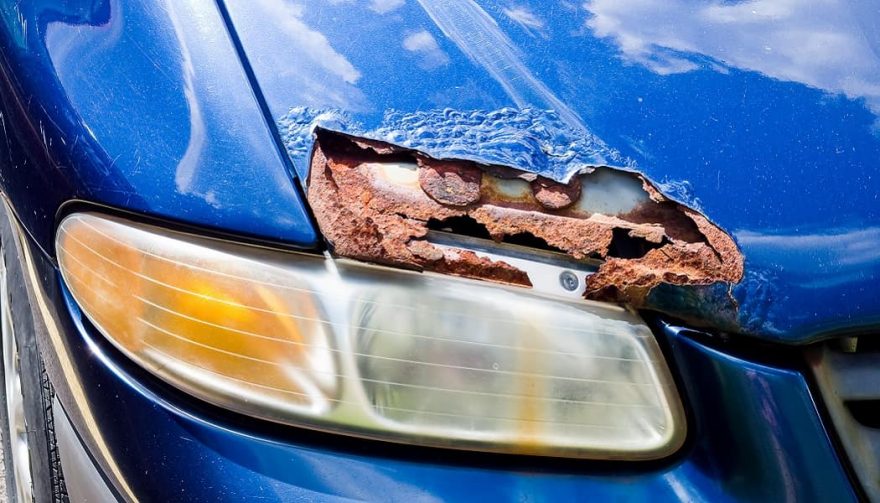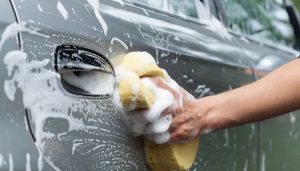
Check your car for rust spots each time you wash it
Knowing When and How to Fix Rust on a Car
Nothing destroys the beauty of a vehicle faster than rust, so it’s important to know how to fix rust on a car. Just a small rock chip in the paint can develop into an unsightly clump of rusty scale, which will soon enough eat a hole right through the body.
Rust doesn’t stop until it has consumed every bit of the host metal that it is feeding on. It sounds like something out of a science fiction movie.
Rust never sleeps and never quits. Rust prevention and abatement is a huge industry worldwide. So, don’t feel bad that your car or project vehicle needs some attention to rust. It would be unusual if it didn’t.
The way you deal with rust depends on what stage you are entering the battle. Think of it as an intervention. That’s right, quit denying that your vehicle has a problem with rust, and get it the help that it deserves and needs.
Repair Those Chips in Your Car’s Paint
The first stage of knowing how to fix rust on a car is the simple paint chip. Small rocks chip the car’s paint, often exposing the primer coat underneath. Primer is soft, offers the metal no protection from the elements and is porous, so it lets in the ingredients of rust, oxygen and moisture.
Those two ingredients begin the chemical reaction with the steel, and soon the alien disease we call rust begins attacking the metal. Not good.
Every six months carefully look over your car’s paint after you wash it. If you don’t have a small bottle of touch up paint, at least apply a drop of clear finger nail polish to each paint chip.
The polish is lacquer, which will dry fast and hard, and offer an amazing amount of protection. Apply it thinly so it looks good. More is not better.
Wash the Salt off Your Car’s Chassis
And speaking of washing the car, don’t neglect the chassis. If you live in a municipality that puts salt on the roads in the winter, you’ve seen what happens when people don’t wash that salt off their cars.
Rust holes in a car’s bodywork are very unsightly. So, drive through a car wash that has an undercarriage wash feature. Once every month or two during the winter should be enough to keep the corrosive salt from making a permanent home under your car.
Advanced Rust Damage Requires Metal Surgery
The final stage in the battle against rust occurs when the rust has won. Once metal is eaten away enough to let light shine through, it will never hold body filler permanently.
No matter how much of the rust you grind away, some of it will always remain in the microscopic pores of the metal. Unseen, it will grow back like that alien disease from a science fiction movie, eat away at the metal, and destroy your meticulous body work.
Dealing with Intermediate Rust Problems
But what if you have some spots on your car that are in between stages, worse than paint chips but not bad enough to warrant an immediate metal surgical procedure? Also, consider your long-term project car.
Many people begin the long build journey by completely dissembling their car, suffering through all the laborious metal stripping and repair, then lose interest and sell the project before it’s finished. The want ads tell the usual tales: “Project Car 90 percent Finished, For Sale Cheap.”
Besides, it’s not good to reassemble an entire vehicle with completely different suspension, brake, wheel, tire, engine and powertrain components and then expect it to drive perfectly. Often the vehicle is a huge disappointment, because nothing seems to work as well as we thought it would.
It was too many changes to make at once. You would be a lot happier if you simply patch the rust places in the body temporarily and attractively, and then make your modifications to the running gear and powertrain one step at a time, driving it in between each stage. Make sense? It’s more fun, too.
Buy Some Time
So, take a tip from the people who do house repair. Sheet metal chimney covers will eventually develop rust, which will ultimately eat through the metal and allow rain water to leak into the chimney. To abate the progress of rust, or to at least slow it down drastically, they use a product from the Rustoleum brand called “rusty metal primer.” Hardware stores sell it by the quart.
Remove as much rust as you can with wire brushes and sandpaper, then brush on a thick coat of the primer. It will help neutralize (so they say) the rust and seal it from the oxygen and humidity in the atmosphere.
Let the primer dry for a week in the hot sun, then brush on a nice coat of whatever color Rustoleum paint you want. It will last an amazingly long time, long enough for you to make some mechanical progress on the rest of the vehicle.
I’ve seen some very acceptable-looking repairs done that way on 4×4 vehicles that are routinely run in mud and dirt. To cover really bad spots, like on rocker panels, people have applied metal duct tape over the primer, then painted that to match their truck as best as possible. It’s only a temporary repair, but from a distance it can look remarkablely good.
Either way, when dealing with rust, it’s often about trying to buy some time. Either protect your beautiful paint and seal all those tiny chips, or perform a decent looking repair on rusty metal until you have time to fix it right.





